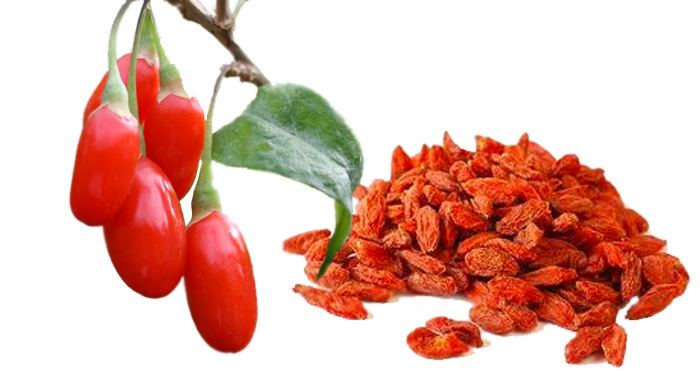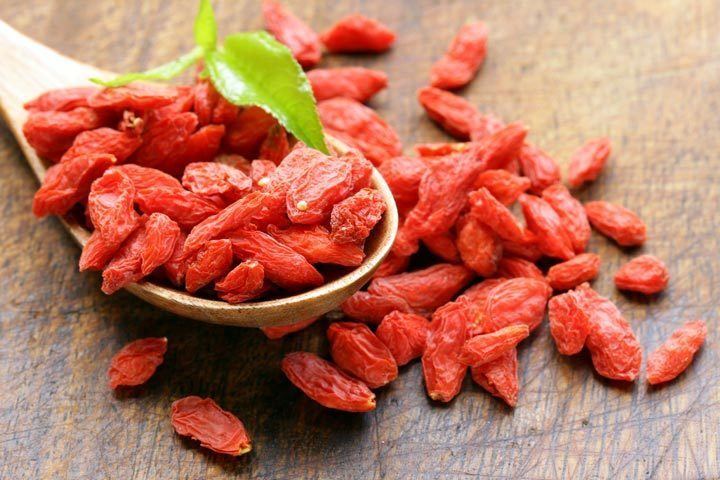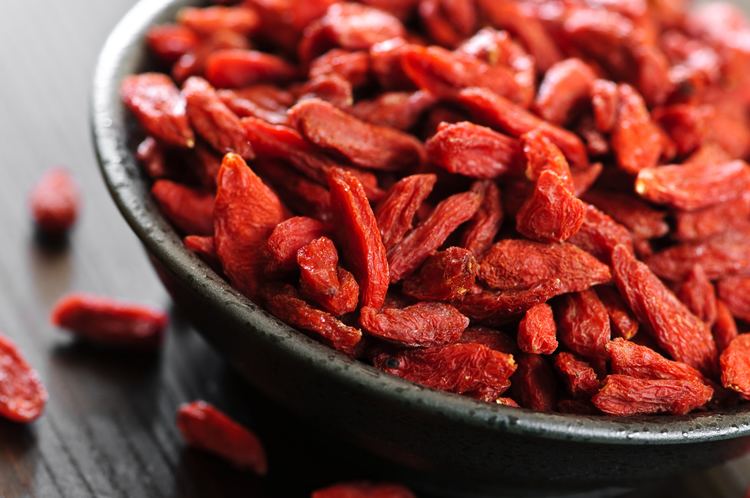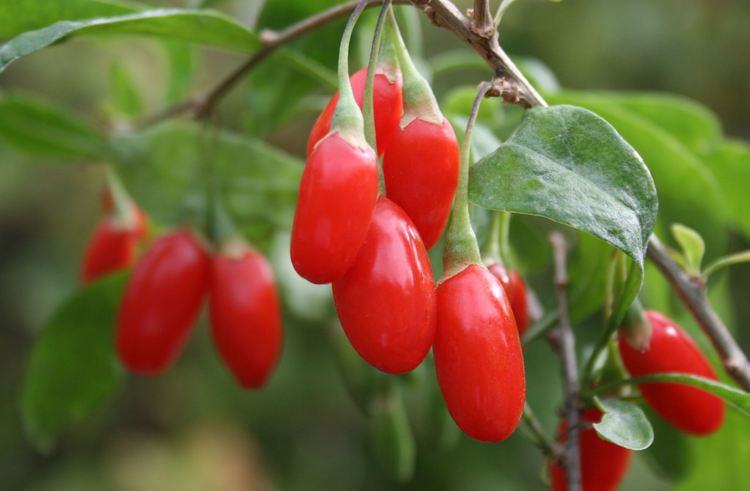 | ||
Similar Jujube, Berry, Chia, Longan, Cranberry | ||
Health benefits of goji berry
Goji, goji berry, or wolfberry (pinyin: gǒuqǐ) is the fruit of either the Lycium barbarum or Lycium chinense, two closely related species of boxthorn in the nightshade family, Solanaceae. The family also includes the potato, tomato, eggplant, belladonna, chili pepper, and tobacco. The two species are native to Asia.
Contents
- Health benefits of goji berry
- Description
- Leaves and flowers
- Fruit
- Naming
- Significance
- China
- Pesticide and fungicide use
- United Kingdom
- Importation of mature plants
- Canada and United States
- Uses
- Culinary
- Medical research
- Safety issues
- Marketing
- Commercial products marketed outside Asia
- No special conditions in the EU
- Marketing claims under scrutiny in Canada and the United States
- References

Description

Wolfberry species are deciduous woody perennial plants, growing 1–3 m high. L. chinense is grown in the south of China and tends to be somewhat shorter, while L. barbarum is grown in the north, primarily in the Ningxia Hui Autonomous Region, and tends to be somewhat taller.
Leaves and flowers

Wolfberry leaves form on the shoot either in an alternating arrangement or in bundles of up to three, each having either a lanceolate (shaped like a spearhead longer than it is wide) or ovate (egg-like) shape. Leaf dimensions are 7.0 cm long by 3.5 cm broad with blunted or rounded tips.
The flowers grow in groups of one to three in the leaf axils. The calyx (eventually ruptured by the growing berry) consists of bell-shaped or tubular sepals forming short, triangular lobes. The corollae are lavender or light purple, 9–14 mm wide with five or six lobes shorter than the tube. The stamens are structured with filaments longer than the anthers. The anthers are longitudinally dehiscent.

In the Northern Hemisphere, flowering occurs from June through September and berry maturation from August to October, depending on the latitude, altitude, and climate.
Fruit

These species produce a bright orange-red, ellipsoid berry 1–2 cm in diameter. The number of seeds in each berry varies widely based on cultivar and fruit size, containing 10–60 tiny yellow seeds that are compressed with a curved embryo. The berries ripen from July to October in the Northern Hemisphere.
Naming
Lycium, the genus name, is derived from the ancient southern Anatolian region of Lycia (Λυκία). The fruit is known in pharmacological references as Lycii fructus, which is Latin for "Lycium fruit".
"Wolfberry", a commonly used English name, has unknown origin, perhaps confusion over the genus name, Lycium, which resembles lycos, the Greek word for wolf.
In the English-speaking world, the name "goji berry" has been used starting around 2000. The word "goji" is an approximation of the pronunciation of gǒuqǐ, the name for L. chinense in several Chinese dialects, including Hokkien and Shanghainese.
In the official classification, L. barbarum is known as matrimony vine and L. chinese as Chinese desert-thorn.
Significance
Since the early 21st century, interest has increased in wolfberries for their novelty and supposed nutrient value. They have been termed a superfruit, which has led to a profusion of consumer products. In traditional medicine, the whole fruit or its extracts are said to have numerous implied health effects, which remain scientifically unconfirmed as of 2014.
China
The majority of commercially produced wolfberries come from the Ningxia Hui Autonomous Region of north-central China and the Xinjiang Uyghur Autonomous Region of western China, where they are grown on plantations totaling 200,000 acres. In Zhongning County, Ningxia, wolfberry plantations typically range between 40 and 400 hectares (100–1000 acres or 500–6000 mu) in area. As of 2005, over 10 million mu have been planted with wolfberries in Ningxia.
Ningxia wolfberries have been cultivated along the fertile floodplains of the Yellow River for more than 700 years and have earned a reputation throughout Asia for premium quality sometimes described commercially as "red diamonds". Government releases of annual wolfberry production, premium fruit grades, and export are based on yields from Ningxia, the region recognized with—
Commercial volumes of wolfberries also grow in the Chinese regions of Inner Mongolia, Qinghai, Gansu, Shaanxi, Shanxi, and Hebei. When ripe, the oblong, red berries are tender and must be picked carefully or shaken from the vine into trays to avoid spoiling. The fruits are preserved by drying them in full sun on open trays or by mechanical dehydration employing a progressively increasing series of heat exposure over 48 hours.
Wolfberries are celebrated each August in Ningxia with an annual festival coinciding with the berry harvest. Originally held in Ningxia's capital, Yinchuan, the festival has been based since 2000 in Zhongning County, an important center of wolfberry cultivation for the region. As Ningxia's borders merge with three deserts, wolfberries are also planted to control erosion and reclaim irrigable soils from desertification.
China, the main supplier of wolfberry products in the world, had total exports generating US$120 million in 2004. This production derived from 82,000 hectare farmed nationwide, yielding 95,000 tons of wolfberries, which has increased from larger acreages cultivated in recent years.
Pesticide and fungicide use
China's Green Food Standard, administered by the Chinese Ministry of Agriculture's China Green Food Development Center, permits some pesticide and herbicide use.
United Kingdom
On June 18, 2007, the UK Food Standards Agency stated a significant history exists of the fruit being consumed in Europe before 1997, and has removed it from the Novel Foods list. It is now legal to sell the wolfberry in the UK as a food as reported by the Food Standards Agency, though with concerns over marketing claims over potential health benefits.
Importation of mature plants
Importation of wolfberry plants into the United Kingdom from most countries outside Europe is illegal, due to the possibility they could be vectors of diseases attacking Solanaceae crops, such as potato or tomato.
Canada and United States
During the first decade of the 21st century, farmers in Canada and the United States began cultivating goji on a commercial scale to meet potential markets for fresh berries, juice, and processed products.
Uses
Wolfberries are usually sold in open boxes and small packages in dried form.
Culinary
As a food, dried wolfberries are traditionally cooked before consumption. Dried wolfberries are often added to rice congee and almond jelly, as well as used in Chinese tonic soups, in combination with chicken or pork, vegetables, and other herbs such as wild yam, Astragalus membranaceus, Codonopsis pilosula, and licorice root. The berries are also boiled as a herbal tea, often along with chrysanthemum flowers and/or red jujubes, or with tea, and packaged teas are also available.
Various wines containing wolfberries (called gǒuqí jiǔ from 枸杞酒) are also produced, including some that are a blend of grape wine and wolfberries.
Young wolfberry shoots and leaves are also harvested commercially as a leaf vegetable.
Medical research
Although goji is the subject of basic research to determine if it has physiological properties, lack of clinical evidence and poor quality control in the manufacture of consumer products prevent goji from being clinically recommended or applied.
Safety issues
In vitro testing has revealed that the tea inhibited warfarin metabolism, providing evidence for possible interaction between warfarin and undefined wolfberry phytochemicals.
Potentially harmful interactions may occur if wolfberry is consumed while taking other medications, such as those metabolised by the cytochrome P450 liver enzymes. Such drugs include warfarin, or drugs for diabetes or hypertension.
Marketing
Since the early 21st century, the dried fruit has been marketed in the West as a health food, often accompanied by scientifically unsupported claims regarding its purported health benefits.
Companies marketing the berries often propagate the unsupported claim that a Chinese man named Li Qing Yuen, who was said to have consumed wolfberries daily, lived to the age of 256 years (1677–1933).
Commercial products marketed outside Asia
The presence of wolfberry in health food stores and grocery markets is increasing in the United Kingdom and other countries.
Other wolfberry consumer applications include:
Commercial suppliers have processed wolfberry as
No special conditions in the EU
In June 2007, the United Kingdom's Food Standards Agency (FSA) published the results of its inquiry concluding that goji berries were not a "novel" food in Europe. The inquiry found that the berries were already in wide use before 1997 and had a history sufficient to suggest safety. The FSA is an advisor to the European Union's European Food Safety Authority. Had the berries been found to be a novel food, goji berries would have required authorisation from the European Council and Parliament.
Marketing claims under scrutiny in Canada and the United States
In January 2007, marketing statements for a goji juice product were the subject of an investigative report by CBC Television's consumer advocacy program Marketplace.
By one specific example in the CBC interview, Earl Mindell (then working for direct-marketing company FreeLife International, Inc.) falsely claimed the Memorial Sloan-Kettering Cancer Center in New York had completed clinical studies showing that use of wolfberry juice would prevent 75% of human breast cancer cases.
During 2006, the U.S. Food and Drug Administration (FDA) placed two goji juice distributors on notice with warning letters about unproven therapeutic benefits. These statements were in violation of the United States Food, Drug and Cosmetic Act [21 USC/321 (g)(1)] because they "establish the product as a drug intended for use in the cure, mitigation, treatment, or prevention of disease" when wolfberries or juice have had no such scientific evaluation. Additionally stated by the FDA, the goji juice was "not generally recognized as safe and effective for the referenced conditions" and therefore must be treated as a "new drug" under Section 21(p) of the Act. New drugs may not be legally marketed in the United States without prior approval of the FDA.
On May 29, 2009, a class action lawsuit was filed against FreeLife in the United States District Court of Arizona. This lawsuit alleges false claims, misrepresentations, false and deceptive advertising and other issues regarding FreeLife’s Himalayan Goji Juice, GoChi, and TaiSlim products. This lawsuit seeks remedies for consumers who have purchased these products over the past several years.
